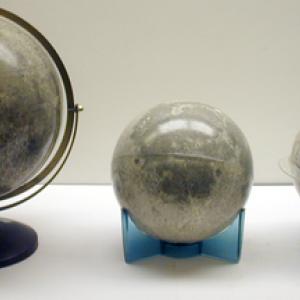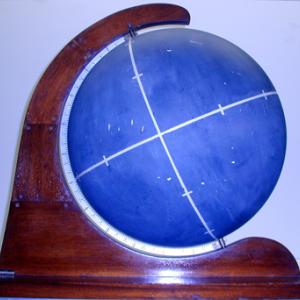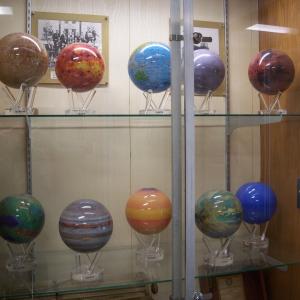College of Liberal Arts & Sciences
8A40.10 - Globes, Planets, and Satellites
No Setup Required. The Chalk globes may be used to show that on a spherical surface the shortest distance between two points is not a straight line. Should the large chalk globe become chipped there is Blackboard Slating paint on hand to be used for touch-up (Kept with the rest of the paints). The Inflatable Globes may be purchased at Lenoch and Cilek or at most good toy stores.
The Sky and Telescope Moon Globe is a mosaic of 15,000 images acquired by the LRO (Lunar Reconnaissance Orbiter) wide angle camera between Nov. 2009 and Feb. 2011. We also have the Sky and Telescope Topographic Moon Globe.
Jupiter, Io, Europa, and Titan globes made from the Voyager, Cassini, and Juno spacecraft image data.
- W. L. Andersen, "Labs to Accompany Treatment of General Relativity in A General Education Astronomy Course", TPT, Vol. 58, #8, Nov. 2020, p. 560.
- Gordon McIntosh, "How Big Is a Planet?", TPT, Vol. 38, #9, Dec. 2000, p. 534.
- Charles A. Eckroth, "Demonstrating the Rule for the Sum of Angles Inside a Triangle", TPT, Vol. 32, #8, Nov. 1994, p. 506.
- Amos Harpaz, "The Formation of a Planetary Nebula", TPT, Vol. 29, #5, May 1991, p. 268.
- B. Cameron Reed, "Dot Products and Great-Circle Distances", TPT, Vol. 26, #5, May 1988, p. 280.
- Edward A. Desloge, "Comment on 'Rescue from Falling into a Black Hole,' by R. T. Hammond [Am. J. Phys. 56, 27-28 (1988)]", AJP, Vol. 57, #7, July 1989, p. 666.
- Dimitrios Psaltis and Feryal Özel, "Imaging Black Holes", Physics Today, Vol. 71, #4, Apr. 2018, p. 70.
- Steven B. Giddings, "Black Holes, Quantum Information, and the Foundations of Physics", Physics Today, Vol. 66, #4, Apr. 2013, p. 30.
- John G. Cramer, "Dinosaur Breath", Analog Science Fiction/Science Fact Magazine, p. 140 - 143.
- Janice VanCleave, "Appendix 3: Planet Facts and Figures", A+ Projects in Astronomy, p. 193.
- Janice VanCleave, "5. Mapping a Sphere: Earth", Geography for Every Kid: Easy Activities that Make Learning Geography Fun, p. 43 - 51.
- Isaac Asimov, "At the Edge", Fantasy and Science Fiction Magazine, p. 133 - 142.
- MOVATM Globe Owners Manual.
Disclaimer: These demonstrations are provided only for illustrative use by persons affiliated with The University of Iowa and only under the direction of a trained instructor or physicist. The University of Iowa is not responsible for demonstrations performed by those using their own equipment or who choose to use this reference material for their own purpose. The demonstrations included here are within the public domain and can be found in materials contained in libraries, bookstores, and through electronic sources. Performing all or any portion of any of these demonstrations, with or without revisions not depicted here entails inherent risks. These risks include, without limitation, bodily injury (and possibly death), including risks to health that may be temporary or permanent and that may exacerbate a pre-existing medical condition; and property loss or damage. Anyone performing any part of these demonstrations, even with revisions, knowingly and voluntarily assumes all risks associated with them.



